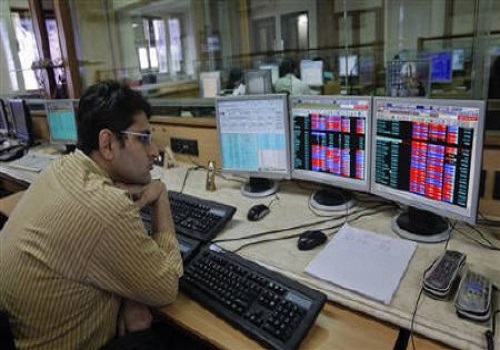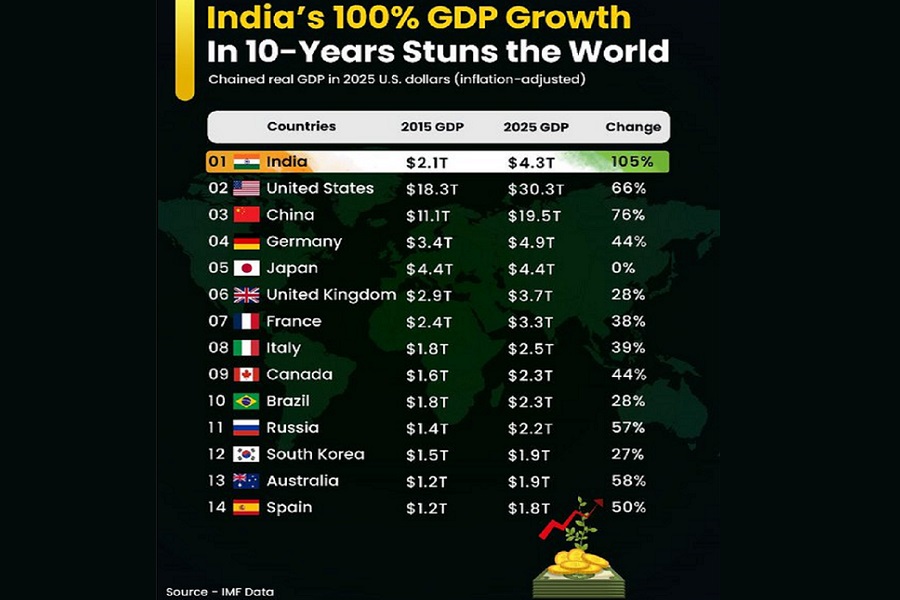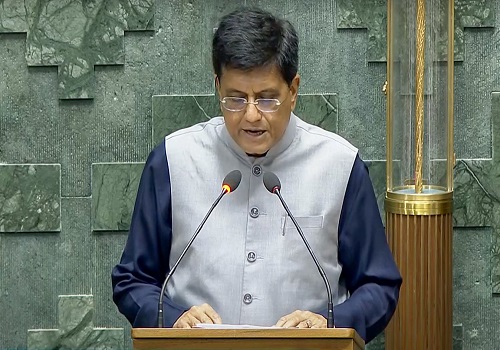Cottoncandy trading range for the day is 53150-55130 - Kedia Advisory

Gold
Gold rose by 1.09% to Rs.85,816, driven by safe-haven demand after U.S. President Donald Trump announced new tariffs on steel and aluminum imports, fueling trade war fears. Additionally, expectations of looser monetary policy from major central banks supported the non-yielding metal. China’s central bank increased its gold reserves for the third consecutive month, holding 73.45 million fine troy ounces by the end of January. Meanwhile, the amount of gold stored in London vaults fell 1.7%, with significant shipments heading to the U.S. amid a high price premium on U.S. gold futures. COMEX gold inventories surged by 93% since late November, with 16.3 million troy ounces (507 tons) added, as traders sought to capitalize on the price arbitrage between London, Switzerland, and the U.S. However, Indian gold demand remained weak, with dealers offering discounts of $31 per ounce, as record-high prices deterred buyers. In China, gold was sold at a $7-$10 discount, while Japanese bullion traded between a $3 discount and a $1 premium. The World Gold Council (WGC) reported an 11% decline in gold jewelry demand in 2024, expecting further pressure in 2025 due to high prices. India’s gold demand in 2025 is projected between 700-800 metric tons, lower than 2024’s nine-year peak of 802.8 tons, though investment demand is expected to rise. Technically, the market is under fresh buying, with open interest increasing by 1.35% to 17,726 contracts, while prices gained Rs.928. Support is at Rs.85,230, with a break below testing Rs.84,640. Resistance is at Rs.86,180, with a move above possibly reaching Rs.86,540.
Trading Ideas:
* Gold trading range for the day is 84640-86540.
* Gold hitting a fresh record high, driven by safe-haven demand after US President Trump announced new global tariffs.
* Further, expectations of looser monetary policy from major central banks are also boosting non-yielding gold.
* Investors continued to anticipate two Fed rate cuts in 2024 despite strong labor data, aligning with FOMC projections.
Silver
Silver closed marginally lower by 0.04% at Rs.95,295, as profit booking offset earlier gains driven by safe-haven demand amid U.S.-China trade tensions. The U.S. economy added 143,000 jobs in January, below expectations of 170,000, while the unemployment rate stood at 4%, slightly better than the forecasted 4.1%. Despite strong labor data, investors still anticipate two Fed rate cuts in 2024, in line with FOMC projections. Market participants now await key U.S. inflation data and Federal Reserve Chair Jerome Powell’s testimony for further direction. On the supply side, the Silver Institute forecasted a fifth consecutive year of market deficit in 2025, with industrial demand and retail investment expected to offset weaker jewelry and silverware consumption. The London Bullion Market Association (LBMA) reported an 8.6% drop in silver inventories in January, marking the largest monthly decline since 2016. Global silver demand in 2025 is projected at 1.2 billion ounces, driven by a 3% rise in industrial fabrication, particularly in the green economy sector. Silver physical investment is also forecast to grow by 3%, though jewelry demand is expected to decline by 6%, primarily in India. Meanwhile, silver mine production is set to reach a seven-year high of 844 Moz, with total supply increasing by 3% to 1.05 billion ounces. Technically, the market is under long liquidation, with open interest dropping by 4.62% to 21,835 contracts, while prices declined by Rs.38. Support is at Rs.94,860, with a break below testing Rs.94,420. Resistance is at Rs.95,880, with a move above possibly reaching Rs.96,460.
Trading Ideas:
* Silver trading range for the day is 94420-96460.
* Silver pared gains on profit booking after prices rose amid escalating trade tensions between the U.S. and China.
* LBMA that silver held in London vaults totalled 23,528 metric tons at the end of January, down 8.6% from the previous month.
* A Labor Department report showed the U.S. economy added 143,000 jobs in January, compared with a rise of 170,000 expected.
Crude oil
Crude oil closed 1.6% higher at Rs.6,337, supported by concerns over tightening global supply amid new U.S. sanctions on Iran’s crude exports. The U.S. Treasury imposed fresh sanctions on individuals and tankers transporting Iranian oil to China, raising fears of reduced Iranian supply. However, the upside was capped by concerns over a potential U.S.-China trade war and U.S. President Donald Trump’s commitment to increasing domestic oil production. According to EIA data, U.S. crude inventories surged by 8.7 million barrels to 423.8 million barrels, far exceeding expectations of a 2-million-barrel rise. Gasoline inventories also grew by 2.2 million barrels, while distillate stockpiles dropped significantly by 5.5 million barrels, indicating higher demand for diesel and heating oil. Crude stocks at the Cushing hub fell slightly by 34,000 barrels, while refinery utilization rates increased by 1%. Additionally, the EIA raised its U.S. oil production estimate to 13.55 million bpd for 2024, with the Permian Basin expected to dominate output growth. The global oil market is expected to see supply growth outpacing demand in the next two years, as OPEC+ eases curtailments and non-OPEC producers ramp up production. The EIA now projects global oil output at 104.4 million bpd in 2025, while demand is expected to remain slightly lower at 104.1 million bpd. Technically, the market is under short covering, with open interest falling by 31.69% to 5,357 contracts, while prices rose by Rs.100. Support is at Rs.6,282, with a break below testing Rs.6,226, while resistance is at Rs.6,372, with a move above potentially pushing prices to Rs.6,406.
Trading Ideas:
* Crudeoil trading range for the day is 6226-6406.
* Crude oil rose amid signs of increasing sanctions and potential disruptions to Russian and Iranian oil flows.
* However, upside seen limited hurt by U.S. President Trump's renewed trade war on China and threats of tariffs on other countries.
* U.S. crude oil imports from Mexico fell by 372,000 barrels per day (bpd) to a weekly record low of 149,000 bpd
Natural Gas
Natural gas jumped 2.98% to close at Rs.303.8, driven by rising LNG export flows and expectations of colder weather boosting heating demand. The U.S. Commodity Futures Trading Commission (CFTC) data showed that speculators trimmed their net long positions for the first time in nine weeks, indicating some profit-taking. Meanwhile, U.S. gas production in the Lower 48 states increased to 106.2 billion cubic feet per day (bcfd) in February, rebounding from January’s freeze-offs that disrupted supply. However, daily output dipped to a one-week low of 105.5 bcfd, suggesting possible short-term constraints. Weather forecasts indicate that colder-than-normal conditions will persist through February 25, leading to higher demand. LSEG projects U.S. gas demand, including exports, to rise from 132.9 bcfd this week to 138.9 bcfd next week, reinforcing bullish sentiment. Additionally, U.S. utilities withdrew 174 bcf of gas from storage, exceeding market expectations of 168 bcf, bringing total inventories down to 2,397 bcf. Storage levels are now 8% lower year-on-year and 4.4% below the five-year average, further supporting prices. The EIA projects record U.S. gas production and demand through 2025, with output expected to reach 104.5 bcfd in 2025 and 107.2 bcfd in 2026, while LNG exports are set to rise from 12.0 bcfd in 2024 to 14.1 bcfd in 2025. Technically, fresh buying was observed, with open interest surging by 13.74% to 15,272 contracts, while prices gained Rs.8.8. Support is at Rs.296.8, with a break below testing Rs.289.9, while resistance is at Rs.307.8, with an upside target of Rs.311.9.
Trading Ideas:
* Naturalgas trading range for the day is 289.9-311.9.
* Natural gas climbed on rising flows to LNG export plants and forecasts for colder weather.
* US gas storage withdrawals may have hit a record high in January
* US gas production on track for record high in February
Copper
Copper prices edged up 0.02% to Rs.867.35, supported by a mix of fundamental factors and trade-related news. Inventories in major Chinese regions rose by 31,700 metric tons (mt) week-on-week to 304,800 mt, a seasonal increase after the Lunar New Year holidays. Compared to pre-holiday levels, Shanghai saw a rise of 71,100 mt, Guangdong 37,400 mt, and Jiangsu 29,000 mt. Additionally, SHFE-monitored warehouse inventories surged by 81.5% since January 24, reaching a five-month high. On the trade front, U.S.-China tensions remain elevated, with new 10% tariffs imposed by the U.S. on Chinese imports, while China responded with retaliatory tariffs of up to 15% on some U.S. imports starting February 10. Despite this, there is room for negotiations, keeping the market cautious. Meanwhile, Chile’s copper exports surged 15.8% YoY to $4.05 billion in January, reflecting strong demand. Cochilco maintained its copper price forecast for 2025 and 2026 at $4.25 per pound, citing long-term supply constraints. The global refined copper market showed a 131,000 mt deficit in November, widening from a 30,000 mt shortfall in October, according to ICSG data. However, for the first 11 months of the year, the market remained in a 168,000 mt surplus. China’s copper imports also remained robust, rising 17.8% YoY to 559,000 mt in December. Technically, the market is experiencing short covering, with open interest declining by 2.77% to 6,288 contracts, while prices saw marginal gains. Support is at ?863.9, with a break below testing Rs.860.3, while resistance is at Rs.870.2, with a potential move towards Rs.872.9.
Trading Ideas:
* Copper trading range for the day is 860.3-872.9.
* Copper settled flat as inventories in China increased by 31,700 mt WoW to 304,800 mt.
* Total inventories rose by 139,000 mt compared to the pre-holiday level of 165,800 mt.
* The Yangshan copper premium, was last at $68 per ton, down from a one-year high of $76 reached on Jan. 20.
Zinc
Zinc prices edged down by -0.02% to Rs.270.75, pressured by a sharp increase of 81.8% in SHFE-monitored inventories since January 24. However, supply concerns limited the downside, as global mined zinc production declined for the third consecutive year in 2024. This was further impacted by a 7% drop in China’s refined zinc output, attributed to lower processing rates and production cuts at major smelters. Additionally, Alaska’s Red Dog Mine, the world’s largest zinc mine, is expected to slow production in 2025, adding further supply constraints. The global zinc market recorded a deficit of 52,900 metric tons in November, narrowing from 65,400 tons in October, according to the International Lead and Zinc Study Group (ILZSG). For the first 11 months of 2024, the market faced a 33,000-ton deficit, a stark contrast to the 312,000-ton surplus in the same period of 2023. Meanwhile, China’s January refined zinc production increased 1% month-on-month but fell nearly 8% year-on-year, reflecting weaker-than-expected output. Production in February 2025 is projected to drop over 8% MoM, with cumulative output for January-February 2025 expected to decline by approximately 6% YoY due to holiday shutdowns and maintenance at key smelters. Technically, the market is under long liquidation, with open interest dropping by 0.81% to 2,819 contracts. Zinc is finding support at Rs.269.1, with a break below potentially testing Rs.267.4. Resistance is at Rs.271.9, with a move above possibly leading to Rs.273.
Trading Ideas:
* Zinc trading range for the day is 267.4-273.
* Zinc dropped as inventories rose 81.8% from last release on Jan 24.
* However downside seen limited amid supply concerns as global mined zinc production fell for the third consecutive year.
* SHFE reopened after the lunar new year holidays and investors are hoping China will unleash more stimulus
Aluminium
Aluminium rose by 1.01% to Rs.260.2, supported by supply risks after Donald Trump announced a 25% tariff on steel and aluminium imports. Additionally, the European Union's plan to phase out Russian aluminium imports has raised concerns over tighter supply. Meanwhile, China produced a record 44 million tons of aluminium in 2024, nearing its 45-million-ton cap, which could limit further production increases. However, fears of escalating U.S.-China trade tensions have capped gains, as China filed a WTO complaint against new U.S. tariffs. On the production side, China’s aluminium output rose 4.2% year-on-year to 3.77 million metric tons in December, though daily output declined by 1.7% from November. Despite an increase in production capacity in Xinjiang, high costs have pushed China’s aluminium producers into losses of 687 yuan per ton, marking the first industry-wide loss in three years. China's aluminium exports increased by 17% YoY to 5.5 million tons in the first ten months of 2024. Additionally, aluminium stocks at Japan’s three major ports rose by 13.2% in December, indicating shifting trade flows. Technically, the market is under short covering, with open interest dropping by 2.67% to 4,193 contracts. Aluminium is finding support at Rs.258.2, with a break below possibly testing Rs.256.2. Resistance is at Rs.261.3, and a move above this level could push prices toward Rs.262.4.
Trading Ideas:
* Aluminium trading range for the day is 256.2-262.4.
* Aluminium rose due to supply risks after U.S. President Trump said he was set to impose new 25% tariffs on all aluminium imports.
* European Union's plan to gradually ban Russian aluminum imports has sparked concerns.
* Global primary aluminium output in December rose 3% year on year to 6.236 million tonnes.
Cottoncandy
Cottoncandy rose by 0.5% to Rs.54,010, supported by adjusted production forecasts and firm demand. Brazil’s 2024-25 cotton production estimate was revised down to 3.79 million tonnes due to reduced acreage in Mato Grosso. Meanwhile, the Cotton Association of India (CAI) increased its crop projection by 2 lakh bales to 304.25 lakh bales, driven by higher output in Telangana, which saw an upward revision of 6 lakh bales. However, cotton arrivals in North India (Punjab, Haryana, and Rajasthan) dropped by 43% compared to last year, causing supply concerns. Some farmers are holding back produce, expecting higher prices, while ginners and spinners are facing raw material shortages, especially in Punjab. The WASDE report projected increased global production and ending stocks for 2024-25, contributing to bearish pressure. Global cotton output is expected to rise by 1.2 million bales to 117.4 million bales, primarily due to higher production in India and Argentina. Despite this, cotton yarn prices in South India have risen, supported by strong demand from the garment sector and export orders. Total cotton supplies in India by December-end stood at 176.04 lakh bales, with consumption reaching 84 lakh bales and exports at 7 lakh bales. December-end stocks were estimated at 85.04 lakh bales, while CAI raised its consumption forecast to 315 lakh bales for the 2024-25 season. Technically, the market is under short covering as open interest declined by 1.54% to 256 contracts. Cottoncandy has support at ?53,580, with a break below possibly testing Rs.53,150. Resistance is at Rs.54,570, and a move above this could push prices toward Rs.55,130.
Trading Ideas:
* Cottoncandy trading range for the day is 53150-55130.
* Cotton gained as Brazil's 2024-25 cotton production forecast was revised down to 3.79 million tonnes.
* CAI has revised upwards its crop projections by 2 lakh bales from its earlier estimates.
* Global cotton production is projected to rise by more than 1.2 million bales to 117.4 million bales.
* In Rajkot, a major spot market, the price ended at 25350 Rupees gained by 0.09 percent.
Turmeric
Turmeric settled down by 1.87% at Rs.13,244 due to weak demand and a slight increase in market arrivals. With harvesting progressing steadily, a higher supply is expected in the coming month, putting additional pressure on prices as end consumers continue to struggle with demand. However, the downside remains limited as new crop yields are estimated to be 10-15% lower this year, particularly in the Nanded region, where smaller rhizomes and crop rot have been reported. The actual impact on yield will be confirmed once harvesting gains momentum in key producing areas. Market arrivals surged to 13,190 bags from 6,780 bags in the previous session, with Nizamabad and Hingoli witnessing higher inflows. Despite the supply pressure, concerns over slow rhizome growth and lower yield estimates continue to support the market. Turmeric exports rose 9.80% during April-November 2024, reaching 121,601.21 tonnes, compared to 110,745.34 tonnes in the same period in 2023. However, November 2024 exports declined by 20.18% from October 2024, but they still showed a 48.22% increase compared to November 2023. Meanwhile, turmeric imports rose sharply by 101.80% in the April-November 2024 period, though November imports dropped by 34.84% from October. Technically, the market is witnessing long liquidation, with open interest down by 0.29% to 12,135 contracts, while prices declined by Rs.252. Support is at Rs.13,144, with a break below leading to Rs.13,042 levels. On the upside, resistance is at Rs.13,414, and a move above this could push prices toward Rs.13,582.
Trading Ideas:
* Turmeric trading range for the day is 13042-13582.
* Turmeric dropped on weak demand and marginal improvement in arrivals.
* However downside seen limited as new crop yields are expected to be 10-15% lower this year.
* Farmers have indicated that the yield may be lower than expected.
* In Nizamabad, a major spot market, the price ended at 13334.95 Rupees gained by 0.12 percent.
Jeera
Jeera settled down by 0.62% at Rs.20,180 as demand remained subdued, and existing stocks continued to meet export requirements. Farmers still hold around 20 lakh bags, with only 3-4 lakh bags expected to be traded by season-end, leaving a carry-forward stock of nearly 16 lakh bags. This has kept prices under pressure despite an overall balanced production outlook. The current season’s production is expected to match last year’s levels due to improved crop conditions and favorable sowing. However, the downside remains limited due to stock shortages in the long term. India’s jeera production increased to 8.6 lakh tonnes from 11.87 lakh hectares in 2023-24, compared to 5.77 lakh tonnes from 9.37 lakh hectares in the previous year. Notably, Indian cumin remains the cheapest in the global market, attracting strong export demand, especially from China and other international buyers. The price of Indian jeera is around $3,050 per tonne, significantly lower than Chinese cumin, which trades at $200-$250 higher. Additionally, tensions in the Middle East have boosted demand for Indian cumin, particularly from Gujarat-based exporters. Jeera exports surged 74.04% YoY to 147,006.20 tonnes during April-November 2024, despite a 28.92% drop in November exports from October levels. However, exports in November jumped 42.67% YoY compared to November 2023. Technically, the market is witnessing fresh selling, with open interest rising by 2.16% to 2,700 contracts while prices declined by Rs.125. Support is at Rs.19,960, with a further downside to Rs.19,740. Resistance is at Rs.20,500, and a breakout above this level could push prices toward Rs.20,820.
Trading Ideas:
* Jeera trading range for the day is 19740-20820.
* Jeera dropped as demand is low and the current export business is being met from the available stock.
* However, only 3-4 lakh bags are expected to be traded by the end of the season, leaving a carry-forward stock of about 16 lakh bags.
* The current season is expected to have similar production levels as last year due to better crop conditions and good sowing.
* In Unjha, a major spot market, the price ended at 20464.45 Rupees gained by 0.6 percent.
Views express by all participants are for information & academic purpose only. Kindly read disclaimer before referring below views








.jpg)













